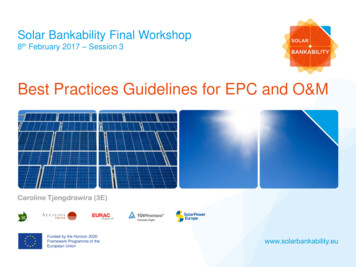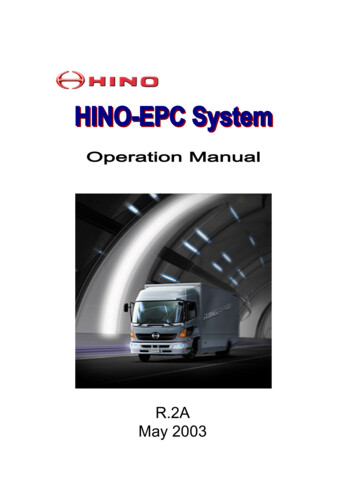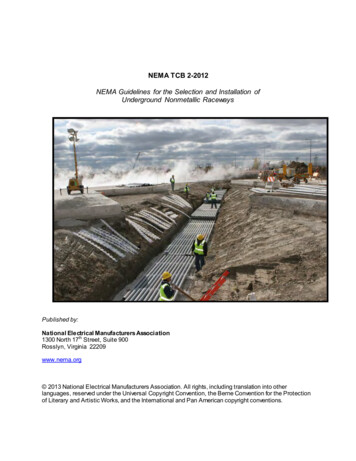
Transcription
Solar Bankability Final Workshop8th February 2017 – Session 3Best Practices Guidelines for EPC and O&MCaroline Tjengdrawira (3E)Funded by the Horizon 2020Framework Programme of theEuropean Union
Presentation OutlineI.Lifecycle costs and related risks in PV investment financial modelII.Gaps in EPC and O&M technical aspectsIII.Best-practice guidelines for EPC and O&M contracting Solar Bankability Final Workshop Brussels 7-8 Feb 2017 2
Lifecycle Costs in PV Investment Financial ModelEPC and O&M are Influential to CAPEX and OPEX» CAPEX is dominant inlifecycle costs(75-90%)» Majority of CAPEX isEPC(70-90%)» Wide O&M range inOPEX(30-70%)Data from surveys of 18 PV financial models (ground-mounted plants, FR-UK-DE-IT, 2011-2015) 8 EPC and O&M contracts (ground-mounted and rooftop plants, FR-UK-IT-NL, 2014-2016) 7 yield reports and scientific literature Solar Bankability Final Workshop Brussels 7-8 Feb 2017 3
Technical Inputs in EPC, O&M and Yield EstimationGaps Analysis in Technical AssumptionsRiskPhase/fieldIdentified critical technical gapsYear-0Procurement/product selectionand testing1.2.3.Planning/lifetime energyyield estimation4.5.6.7.RisksduringoperationInsufficient EPC technical specifications to ensure that selected componentsare suitable for use in the specific PV plant environment of application.Inadequate component testing to check for product manufacturingdeviations.Absence of adequate independent product delivery acceptance test andcriteria.The effect of long-term trends in the solar resource is not fully accountedfor.Exceedance probabilities (e.g. P90) are often calculated for risk assessmentassuming a normal distribution for all elements contributing to the overalluncertainty.Incorrect degradation rate and behavior over time assumed in the yieldestimation.Incorrect availability assumption to calculate the initial yield for projectinvestment financial model (vs O&M plant availability on9.Installation/provisional andfinal acceptance11. Inadequate protocol or equipment for plant acceptance visual inspection.12. Missing short-term performance (e.g. PR) check at provisional acceptancetest, including proper correction for temperature and other losses.13. Missing final performance check and guaranteed performance.14. Incorrect or missing specification for collecting data for PR or availabilityevaluations: incorrect measurement sensor specification, incorrectirradiance threshold to define time window of PV operation forPR/availability calculation.» Gaps exist across allproject phasesAbsence of standardized transportation and handling protocol.Inadequate quality procedures in component un-packaging and handlingduring construction by workers.10. Missing intermediate construction monitoring.Operation15. Selected monitoring system is not capable of advanced fault detection andidentification.16. Inadequate or absence of devices for visual inspection to catch invisibledefects/faults.17. Missing guaranteed key performance indicators (PR, availability or energyyield).18. Incorrect or missing specification for collecting data for PR or availabilityevaluations: incorrect measurement sensor specification, incorrectirradiance threshold to define time window of PV operation forPR/availability calculation.Maintenance19. Missing or inadequate maintenance of the monitoring system.20. Module cleaning missing or frequency too low.Data from surveys of 18 PV financial models (ground-mounted plants,FR-UK-DE-IT, 2011-2015) 8 EPC and O&M contracts (ground-mounted androoftop plants, FR-UK-IT-NL, 2014-2016) 7 yield reports and scientific literature Solar Bankability Final Workshop Brussels 7-8 Feb 2017 4
Gaps in EPC ContractingYear-0 RisksProcurement, Product Selection and Testing Insufficient EPC technical specifications for major plant components Inadequate component testing Absence of product acceptanceTransportation Absent standard protocol for transport and handlingConstruction Inadequate protocol for component handling by workers Missing construction monitoring Solar Bankability Final Workshop Brussels 7-8 Feb 2017 5
Gaps in EPC ContractingYear-0 RisksProvisional and final acceptance Inadequate visual inspection protocolMissing/incorrect short-term performance check at provisional acceptanceMissing/incorrect final performance checkAbsence of guaranteed performanceMissing/incorrect:– Assumptions in performance calculation– Measurement sensor specification– Irradiance threshold Solar Bankability Final Workshop Brussels 7-8 Feb 2017 6
Gaps in O&M ContractingRisks During OperationOperation Inadequate monitoring system for advanced fault detection andidentification Inadequate visual inspection protocol Absence of guaranteed performance Missing/incorrect:– Assumptions in performance calculation– Measurement sensor specification– Irradiance thresholdMaintenance Missing/inadequate monitoring system maintenance Module cleaning missing or frequency too low Solar Bankability Final Workshop Brussels 7-8 Feb 2017 7
PV Financial Model – Technical RisksGaps in Technical Assumptions Leading to Technical Risks Impacting PVInvestment CostsGAPS Incorrect set-ups ofEPC and O&M Incorrect yieldestimationRISKS Type 1 risksinfluence plantperformance andyield Type 2 risks causepartial or overallplant outage lowering plantavailability and yieldLCOE Increase costs(CAPEX or OPEX) Over- or underestimation of yield Solar Bankability Final Workshop Brussels 7-8 Feb 2017 8
Managing PV Technical RisksTechnical Aspects in EPC and O&M Contracts» Are important since they affect CAPEX, OPEX or yield.» Need to be set up properly to minimize technical risks.EPCO&M Solar Bankability Final Workshop Brussels 7-8 Feb 2017 9
Best Practice ChecklistsTools to Minimize Technical Risks by Proper EPC and O&M Contracting andYield EstimationThree main checklists are:1.2.3.Best Practice Checklist for EPC Technical AspectsBest Practice Checklist for O&M Technical AspectsBest Practice Checklist for Long-Term Yield AssessmentThree supplementary checklists are:4.5.6.Checklist for As-Build Documents – Type and DetailsChecklist for Record ControlChecklist for Reporting Indicators Solar Bankability Final Workshop Brussels 7-8 Feb 2017 10
Best-Practice for EPC and O&M ContractingTechnical Aspects & What to Look for in The ContractsEPC contractABCDEFGHIJDefinitions, interpretationContractual commitmentsScope of works – engineeringScope of works – procurementScope of works – constructionScope of works – administrative and othersManufacturer warrantiesEPC warranty and Defect Liability Period (DLP)Key performance indicators (KPIs) and guaranteesCommissioning and acceptanceO&M contractABCDEFGHIJDefinitions, interpretationPurpose and responsibilitiesScope of works – environmental, health and safetyScope of works – operationsScope of works – maintenanceScope of works – data and monitoringScope of works – spare parts managementScope of works – plant securityKey performance indicators (KPIs)Contractual commitments Solar Bankability Final Workshop Brussels 7-8 Feb 2017 11
Best Practice ChecklistsOnline at www.solarbankability.eu Solar Bankability Final Workshop Brussels 7-8 Feb 2017 12
Technical Risk Flash CardsOnline at www.solarbankability.euCategorization based on: Risk impacts CAPEX/OPEX/yield Risk mitigation impacts on CAPEX/OPEX/yieldRiskRiskRiskPhase of risk occurrence1. Insufficient EPC technical specifications to ensurethat selected components are suitable for use in thePhase of riskoccurrenceProcurementPlanning1. InsufficientEPC technicalspecificPV plant environmentofspecificationsapplication to ensurethat selected components are suitable for use in the PhaseofriskoccurrenceProcurementPlanning1. InsufficientEPC technicalspecificPV plant environmentofspecificationsapplication to ensurethat selected components are suitable for use in theO&M ConstructionProcurementPlanningspecific PV plant environment of applicationO&M ConstructionKey takeawayRisk flash cards with following info: Description of the risk,Phase at which the risk occurs,Key takeaway of the risk,Mitigations,Risk and mitigation impacts on LCOEPV plant component specification and requirement in the EPC contract should be as detail asO&MConstructionpossible to ensure that the components procured are suited for the intended PV installationKey takeaway specificPV application,plant componentspecificationand requirement in the EPC contract should be as detail assite andenvironmentpossible to ensure that the components procured are suited for the intended PV installationKey takeaway specificPV application,plant componentspecificationand requirementcontract should Yieldbe as detail assite andenvironmentCAPEXin the EPC OPEXImpact of riskLCOE variablesimpactedby thatthis risk:possibleto ensurethe components procured are suited for the intended PV installation specific application, site and environmentCAPEXOPEXYieldImpact of riskLCOE variables impacted by this risk: Mitigations Component testingWhen specifying the technicalrequirementsforPVCAPEXOPEXYieldImpact of risk DesignLCOEvariablesimpactedplantby thisrisk:componentsin the EPC contract, in addition toreview Mitigations Component the component type and quantity, the specificationsconstruction monitoringplantin the EPC contract, in addition to Design review shouldalsocomponentsinclude: EPC qualificationMitigations Component the component type and quantity, the specificationsconstruction monitoring plantin thecontract, in additionto Advancedmonitoring Designreview shouldalsocomponentsinclude: EPC qualificationIEC61215,IEC61730, typeIEC61701,IEC62804,the componentand toring Basic monitoring (e.g. Advanced d also include: EPCqualificationIEC61730,IEC61716 AdvancedinspectionmarkIEC61215,of compliancefor allIEC61701,electrical IEC62804,components) Basic monitoring modules;All applicablecertificationsandAdvanced ters; CE (e.g. Visual inspection The environmentalconditionthecomponentswill IEC61716IEC61215,IEC61730,IEC61701,IEC62804, Advanced ts) Basic monitoring Yield/performancetestbe installed(temperature,humidity,windfor inmodules;IEC62109,IEC61000forandinverters; CE Visual inspection Theenvironmentalconditionthecomponentswill Advanced nceforexposure,allelectricalcomponents) Yield/performance osion risk etc.) Visual inspection The environmental condition the components will snow load, any special chemical exposure,Yield/performance test For PVmodules,modulecomponent billofbe installedin (temperature,humidity,wind andcorrosionrisketc.)materialssnowand theproofIEC certificationload,any ofspecialchemical exposure, For PVmodules,moduledocumentsfor thesematerialscorrosionrisketc.) component bill ofmaterials and the proof of IEC certification For PVCAPEXmodules,modulebill ofdocumentsfor these materialsOPEXcomponentYieldLCOE variables impacted by the riskmaterials and the proof of IEC certificationmitigations: documentsCAPEXfor these materialsOPEXYieldLCOE variables impacted by the riskImpact ofmitigationImpact ofmitigationImpact ofmitigationmitigations:LCOE variables impacted by the riskmitigations:CAPEXOPEX Solar Bankability Final Workshop Brussels 7-8 Feb 2017 Yield 13
ReportsOnline at www.solarbankability.euDeliverable D3.1 report “Review and Gap Analyses of Technical Assumptions in PVElectricity Cost – Report on Current Practices in How TechnicalAssumptions are Accounted in PV Investment Cost Calculation”Deliverable D3.2 report “Best Practice Guidelines for PV Cost Calculation – Accountingfor Technical Risks and Assumptions in PV LCOE” Solar Bankability Final Workshop Brussels 7-8 Feb 2017 14
Thank youPRESENTED BYCaroline Tjengdrawiractj@3e.euThis project has received funding from the European Union’s Horizon 2020 research and innovation programme under grant agreement No 649997.The content of this report reflects only the author’s view and the Commission is not responsible for any use that may be made of the information it containsFunded by the Horizon 2020Framework Programme of theEuropean Union
Best Practice Checklist for EPC Technical Aspects 2. Best Practice Checklist for O&M Technical Aspects 3. Best Practice Checklist for Long-Term Yield Assessment Three supplementary checklists are: 4. Checklist for As-Build Documents -Type and Details 5. Checklist for Record Control 6. Checklist for Reporting Indicators










